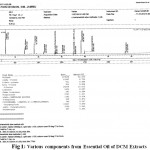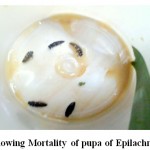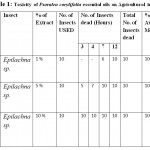Chemical Composition and Insecticidal Activity of Essential oil obtained from DCM Extracts of Psoralea corylifolia against Agricultural pest
Monika Gupta1 * , Aditi Gupta1 and Sudhakar Gupta1
1
Department of Chemistry,
Lovely Professional University,
Phagwara,
Punjab,
144806
India
DOI: http://dx.doi.org/10.12944/CWE.8.2.18
Copy the following to cite this article:
Gupta M, Gupta A, Gupta S. Chemical Composition and Insecticidal Activity of Essential oil obtained from DCM Extracts of Psoralea corylifolia against Agricultural pest. Curr World Environ 2013;8(2) DOI:http://dx.doi.org/10.12944/CWE.8.2.18
Copy the following to cite this URL:
Gupta M, Gupta A, Gupta S. Chemical Composition and Insecticidal Activity of Essential oil obtained from DCM Extracts of Psoralea corylifolia against Agricultural pest. Curr World Environ 2013;8(2). Available from: http://www.cwejournal.org/?p=3900
Download article (pdf)
Citation Manager
Publish History
Select type of program for download
| Endnote EndNote format (Mac & Win) | |
| Reference Manager Ris format (Win only) | |
| Procite Ris format (Win only) | |
| Medlars Format | |
| RefWorks Format RefWorks format (Mac & Win) | |
| BibTex Format BibTex format (Mac & Win) |
Article Publishing History
| Received: | 2013-03-12 |
|---|---|
| Accepted: | 2013-05-05 |
Psoralea corylifolia L. is an important medicinal plant found in the tropical and subtropical regions of the world. It was found to synthesize diverse phenyl propanoids such as furanocoumarins, isoflavonoids etc.1-2 These compounds are mainly used to cure leucoderma, leprosy, psoriasis and inflammatory diseases of skin.3 The review reveals that it possess important activities like antibacterial, anti-inflammatory, antitumour, hepatoprotective, antioxidant and antihelminthic.4 The insecticidal activity is due to the presence of secondary metabolites. The wild population of this medicinally important plant exhibits high mortality of the seedlings, and plant populations decline very quickly due to indiscriminate and illegal collections, and destruction of habitats. Therefore, this species has been included in the list of endangered plants.5-6 Thus the objective of the present study is to find out the insecticidal activity of essential oils against crop pests. The herbal drugs have been used throughout the world have received greater attention in recent times, because of its diversity of curing diseases safety and well tolerated remedies compared to the conventional medicines. A rational approach is being developed to use medicinal plants as an insecticide. The insecticidal activity is due to the presence of active molecules.7
Materials and Methods
Collection and Identification
The seeds of the plant Psoralea corylifolia were purchased from an authentic seed shop of Jammu District and Identified by Dr. Rajesh Manhas of University of Jammu, India.
Extraction
The seeds were dried on laboratory benches at room temperature for seven days, crushed, soxhlated with DCM to get crude extract which is than subjected to Column Chromatography and oil obtained from 1:1 Pet. Ether: DCM was hydro distilled with Clevenger type apparatus to get essential oil. The essential oil was stored in airtight glassware in refrigerator at 4â°C until being used in the treatment.8
GC-MS Analysis of Extracted Oil
The oily fraction was analyzed by using Varian 4000 GC-MS/MS unveiled the presence of following components:
 |
Figure 1: Various components from Essential Oil of DCM Extracts Click here to View figure |
Insecticidal Testing
The essential oils obtained were dissolved in distilled water at three different concentrations (1 %v/v, 5 % v/v, 10 % v/v). i.
Insect Assayed
The Epilachna insect were collected from the fields and identified by Entomologist Dr. Sudhakar Gupta of Zoology Department of Lovely Professional University.
Determination of Insecticidal Activity by Contact toxicity assay
The Wheat leaves are taken from the field, washed, dried and then dipped in the respective percentage of essential oils (i.e. 1%, 5%, 10% v/v) for two hours and then 10 insects are allowed to feed on these leaves in each jar under controlled conditions of temperature and humidity. Control dishes with DCM, distilled water and without solvent were performed separately up to 72 hours. Mortality was assessed after 3, 4, 7 and 12 h of the treatment. The calculation of mortality rate was corrected for control mortality according to Abbott’s formula9:
Mc = (Mo-Mc/100-Me) * 100
Results and Discussion
Controlled experiments have demonstrated no toxicity against the insects. The results are mentioned below:
 |
Figure 2: Showing Mortality of pupa of Epilachna insect Click here to View figure |
 |
Table 1: Toxicity of Psoralea corylifolia essential oils on Agricultural insect Click here to View table |
The essential oil from Psoralea corylifolia shows strong toxic effect against Epilachna sp.
Acknowledgements
The authors are grateful to Dr. Ravikant Khajuria of IIIM Jammu for GC-MS Analysis, Dr. Rajesh Manhas of University of Jammu for identification of plant and LPU for its Lab facilities.
References
- Abhyankar G., Reddy V.D., Giri C.C., Rao K.V., Lakshmi V.V.S., Prabhakar S., Vairamani M., Thippeswamy B.S. and Bhattacharya P.S., Phytochemistry., 66, 2441-2457, 2005.
- Boardley M., Stirton C.H. and Harborne J.B., Africa. Biochem. Syst. Ecol., 14, 603–613, 1986.
- Chadha C., Wealth of India. Raw materials, vol. VIII, pp. 296–298, 1985.
- Uikey S.K., Yadav A.S., Sharma A.K., Rai A.K., Raghuwanshi D.K. and Badkhane Y., International Journal of Phytomedicine., 2, 100-107, 2010.
- Jan S., Parween T., Siddiqi T.O. and Mahmooduzzafar, Journal of Environmental Radioactivity., 113, 142-149, 2012.
- Baskaran P. and Jayabalan N., Acta Physiol. Plant., 30, 345-351, 2008.
- Kumar J.A., Rekha T., Devi S.S., Kannan M., Jaswanth A. and Gopal V., J. Chem. Pharm. Res., 2(5), 177-180, 2010.
- Sukari M.A., Rahmani M., Manas A.R. and Takahashi S., Pertanika., 14(1), 41-44, 1992.
- Mostafa M., Hossain H., Hossain M.A., Biswas P.K. and Haque M.Z., Journal of Advanced Scientific Research., 3(3), 80-84, 2012.






